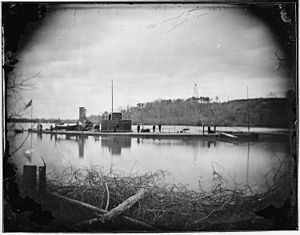Passaic-class monitor
This article includes a list of generalreferences,butit lacks sufficient correspondinginline citations.(February 2013) |
 USSLehighon the James River
| |
| Class overview | |
|---|---|
| Builders |
|
| Preceded by | USSMonitor |
| Succeeded by | Canonicusclass |
| Subclasses | Uraganclass |
| In commission | 25 November 1862 – 1899 |
| Completed | 10 |
| Lost | 2 |
| General characteristics | |
| Type | Monitor |
| Displacement | 1,335 tons |
| Tons burthen | 844 (bm)[1] |
| Length | 200 ft (61 m) overall |
| Beam | 46 ft (14 m) |
| Draught | 10 ft 6 in (3.20 m) |
| Propulsion | 2Martin boilers,1-shaft Ericsson vibrating lever engine, 320ihp(240 kW) |
| Speed | 7knots(13 km/h; 8.1 mph) |
| Complement | 75 |
| Armament |
|
| Armor |
|
ThePassaic-classironcladmonitorsof theU.S. Navysaw service in theU.S. Civil Warand theSpanish–American War.The class was an improved version ofUSSMonitorequipped with a 15-inchDahlgren gunin place of one of the 11-inch guns.[2]
Design[edit]


Naval architect and engineerJohn Ericssondesigned thePassaic-class warships, drawing upon lessons learned from the firstUSSMonitor,which he also designed. ThePassaicmonitors were larger than the originalMonitorand had their pilothouses atop the turret, rather than near the bow. This allowed a wider field of view and easier communications between captain, pilot and crew. The shape of the hull was an improvement; a fuller and rounder lower hull, far more boat-like than that of theMonitor,and with a less pronounced overhang. ThePassaicclass featured an 18 ft (5.5 m) funnel and improved ventilation. In combination, the significant hydrodynamic refinements and improved draught to the boilers resulted in a one-knot speed increase over the prototype monitor, despite thePassaichaving alowerspecific powerthanMonitor(Passaicbeing almost 400 tons heavier and yet with the same 320ihp-rated machinery).
Having observed the new 15-inchRodman cannonin fortifications and disappointed with the performance of the 11-inch Dahlgren versusCSSVirginia,Assistant Secretary of the NavyGustavus Foxrequired the new monitors to be equipped with at least one gun of 15-inch caliber, resulting in rush production of a new 15-inch Dahlgren.[3][4]The turret was 21 ft (6.4 m) in diameter inside with the 15 in (380 mm) gun mounted flush because the muzzle diameter was too large for the turret opening. The large volume of propellant gases released inside the turret required the addition of a "smoke box" at the muzzle in the interior of the turret.[5]As a result, the 15 in gunners could not see their targets and had to aim with the 8 in (200 mm) or 11 in (280 mm) guns.Lehighhad her 11-inch smoothbore replaced with an 8-inchParrott rifle.Passaicalso had this modification by July 1863, and, eventually, all surviving members of this class had an additional 15-inch smoothbore added. Later improvements included an additional 50 tons of deck plating over the magazines and machinery spaces as well as rings fitted around the turret and pilot houses to prevent their pivoting machinery from being jammed by shot.
Ships in class[edit]
Warships ofPassaicclass included:
The first ship of the class was named for the city ofPassaic, New Jersey.
See also[edit]
- Uragan-class monitor,anImperial Russian Navymonitor type built to the plans of the AmericanPassaicclass.
Notes[edit]
References[edit]
- Canney, Donald L. (1993).The Old Steam Navy: The Ironclads, 1842–1885.Vol. 2. Annapolis, Maryland: Naval Institute Press.ISBN0-87021-586-8.
- Gibbons, Tony (1989).Warships and Naval Battles of the Civil War.New York: Gallery Books.ISBN0-8317-9301-5.
- Olmstead, Edwin; Stark, Wayne E.; Tucker, Spencer C. (1997).The Big Guns: Civil War Siege, Seacoast, and Naval Cannon.Alexandria Bay, New York: Museum Restoration Service.ISBN0-88855-012-X.
- Silverstone, Paul H. (2006).Civil War Navies 1855–1883.The U.S. Navy Warship Series. New York: Routledge.ISBN0-415-97870-X.
- Tucker, Spencer C. (1989).Arming the Fleet: U.S. Naval Ordnance in the Muzzle-Loading Era.Annapolis, Maryland: Naval Institute Press.ISBN0-87021-007-6.
- Wright, Christopher C. (June 2021). "Canonicusat Jamestown, 1907 ".Warship International.LVIII(2): 126–162.ISSN0043-0374.
